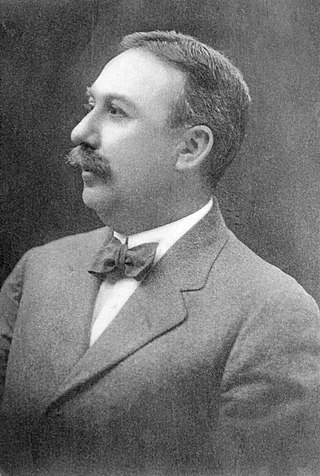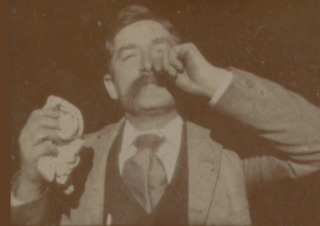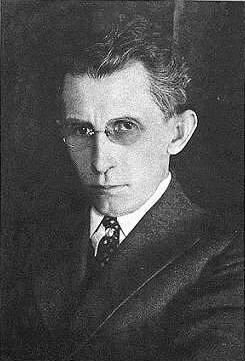
William Kennedy Laurie Dickson was a British-American inventor who devised an early motion picture camera under the employment of Thomas Edison.

The Kinetoscope is an early motion picture exhibition device, designed for films to be viewed by one person at a time through a peephole viewer window. The Kinetoscope was not a movie projector, but it introduced the basic approach that would become the standard for all cinematic projection before the advent of video: it created the illusion of movement by conveying a strip of perforated film bearing sequential images over a light source with a high-speed shutter. First described in conceptual terms by U.S. inventor Thomas Edison in 1888, it was largely developed by his employee William Kennedy Laurie Dickson between 1889 and 1892. Dickson and his team at the Edison lab in New Jersey also devised the Kinetograph, an innovative motion picture camera with rapid intermittent, or stop-and-go, film movement, to photograph movies for in-house experiments and, eventually, commercial Kinetoscope presentations.

Edwin Stanton Porter was an American film pioneer, most famous as a producer, director, studio manager and cinematographer with the Edison Manufacturing Company and the Famous Players Film Company. Of over 250 films created by Porter, his most important include What Happened on Twenty-third Street, New York City (1901), Jack and the Beanstalk (1902), Life of an American Fireman (1903), The Great Train Robbery (1903), The European Rest Cure (1904), The Kleptomaniac (1905), Life of a Cowboy (1906), Rescued from an Eagle's Nest (1908), and The Prisoner of Zenda (1913).

Fred Ott's Sneeze is an 1894 short, black-and-white silent film shot by William K.L. Dickson and featuring Fred Ott. According to the Library of Congress, it is the second oldest surviving U.S. motion picture to be copyrighted, although it is now in the public domain.

The Biograph Company, also known as the American Mutoscope and Biograph Company, was a motion picture company founded in 1895 and active until 1916. It was the first company in the United States devoted entirely to film production and exhibition, and for two decades was one of the most prolific, releasing over 3000 short films and 12 feature films. During the height of silent film as a medium, Biograph was the most prominent U.S. film studio and one of the most respected and influential studios worldwide, only rivaled by Germany's UFA, Sweden's Svensk Filmindustri and France's Pathé. The company was home to pioneering director D. W. Griffith and such actors as Mary Pickford, Lillian Gish, and Lionel Barrymore.

Edison Studios was an American film production organization, owned by companies controlled by inventor and entrepreneur, Thomas Edison. The studio made close to 1,200 films, as part of the Edison Manufacturing Company (1894–1911) and then Thomas A. Edison, Inc. (1911–1918), until the studio's closing in 1918. Of that number, 54 were feature length, and the remainder were shorts. All of the company's films have fallen into the public domain because they were released before 1928.

The Lubin Manufacturing Company was an American motion picture production company that produced silent films from 1896 to 1916. Lubin films were distributed with a Liberty Bell trademark.

The Independent Moving Pictures Company (IMP) was a motion picture studio and production company founded in 1909 by Carl Laemmle. The company was based in New York City, with production facilities in Fort Lee, New Jersey. In 1912, IMP merged with several other production companies to form Universal Film Manufacturing Company, later renamed Universal Pictures Company with Laemmle as president.

Carmencita is an 1894 American short black-and-white silent documentary film directed and produced by William K.L. Dickson, the Scottish inventor credited with the invention of the motion picture camera under the employ of Thomas Edison. The film is titled after the dancer who features in it.

Another Job for the Undertaker is a 1901 silent comic trick film made at Edison's recently opened studio at 41 East 21st Street in Manhattan. It was photographed by Edwin S. Porter and co-directed by Porter and George S. Fleming. The two-shot film was copyrighted on May 15, 1901 and is approximately two minutes in length. It lacks a head title, which would have been supplied by projecting a separate lantern slide before screening the film.

James Searle Dawley was an American film director, producer, screenwriter, stage actor, and playwright. Between 1907 and the mid-1920s, while working for Edison, Rex Motion Picture Company, Famous Players, Fox, and other studios, he directed more than 300 short films and 56 features, which include many of the early releases of stars such as Douglas Fairbanks, Mary Pickford, Pearl White, Marguerite Clark, Harold Lloyd, and John Barrymore. He also wrote scenarios for many of his productions, including one for his 1910 horror film Frankenstein, the earliest known screen adaptation of Mary Shelley's 1818 novel. While film direction and screenwriting comprised the bulk of Dawley's career, he also had earlier working experience in theater, performing on stage for more than a decade and managing every aspect of stagecraft. Dawley wrote at least 18 plays as well for repertory companies and for several Broadway productions.

The Charge of the Light Brigade is a 1912 American silent historical drama film directed by J. Searle Dawley (1877-1949). Produced by the Edison Studios, the film portrays the disastrous yet inspiring military attack in October 1854 by British light cavalry against Imperial Russian artillery positions in the Battle of Balaclava during the Crimean War (1854-1856), in the Crimea of southern Russia along the Black Sea coast. Director Dawley also wrote the scenario for this production, adapting it in part from the famous 1854 narrative poem about the charge by British poet laureate Alfred, Lord Tennyson (1809-1892), who completed his poem just six weeks after the actual battle event. The film's action scenes and landscape footage were shot between late August and early September 1912, while Dawley and his company of players and crew were on location in Cheyenne, Wyoming. In order to produce a sizable and believable recreation of the charge, the director needed a very large number of horsemen. Fortunately for Dawley, the commander of United States Army cavalry at Fort D. A. Russell at Cheyenne agreed to provide "about 800" mounted Army Cavalry troopers and "their trained mounts" to the Edison filming project of the new cinematic invention.

The Countryman and the Cinematograph is a 1901 British short silent comedy film, directed by Robert W. Paul, featuring a stereotypical yokel reacting to films projected onto a screen. The film "is one of the earliest known examples of a film within a film", where, according to Michael Brooke of BFI Screenonline, "the audience reaction to that film is as important a part of the drama as the content of the film itself".

Kansas Saloon Smashers is a 1901 comedy short film produced and distributed by Edison Studios. Directed by Edwin S. Porter, it is a satire of American activist Carrie Nation. The film portrays Nation and her followers entering and destroying a saloon. After the bartender retaliates by spraying Nation with water, policemen order them out; the identities of the actors are not known. Inspiration for the film was provided by an editorial cartoon which appeared in the New York Evening Journal.
The Boston Tea Party is a 1908 silent film directed by Edwin S. Porter, and produced and distributed by Edison Studios. The film is a fictionalized depiction of the events of the December 16, 1773, Boston Tea Party. It was the film debut of actor Charles Stanton Ogle.

Norman C. Raff and Frank R. Gammon were two American businessmen who were known for distributing and promoting some of the Edison Studio films, and founding their own business, which was called The Kinetoscope Company.

The Battle of Trafalgar is a lost 1911 American silent docudrama film that portrayed the 1805 victory of Great Britain’s Royal Navy over the combined naval forces of France and Spain during the Napoleonic Wars. The death of British Vice-Admiral Horatio Nelson in that decisive sea battle was also depicted in this "one-reeler", which was directed by J. Searle Dawley and produced by Thomas A. Edison, Inc. The film starred Sydney Booth with Herbert Prior, James Gordon, Charles Ogle, and Laura Sawyer in supporting roles.

The Leonard–Cushing Fight is an 1894 American short black-and-white silent film produced by William K.L. Dickson, starring Mike Leonard and Jack Cushing. Leonard and Cushing participate in a six-round boxing match under special conditions that allow for it to be filmed and displayed on a Kinetograph. The film was shot on an uncertain date between May 24 and June 14, 1894, in a specially configurated ring in Edison's Black Maria film studio in West Orange, New Jersey. Premiered on August 4, 1894 in Manhattan, the movie is the first sports film ever released. As of 2023, no full print of the film is known to have survived, making it a partially lost film. A 23-second fragment is available at the Library of Congress.

The Relief of Lucknow is a 1912 American silent film about the Relief of Lucknow during the Indian Rebellion of 1857. Filmed in 1911 by the Edison Company at locations in the Imperial fortress colony of Bermuda, including the Prospect Camp Garrison Golf Links clubhouse, "Walsingham House", and the walled streets of St. George's town.

For Valour is a 1912 silent American short film made by the Edison Manufacturing Company. It stars Laura Sawyer, Richard R. Neill, Ben Wilson, and James Gordon. It is based on the short story of the same name by Talbot Mundy. It was directed by J. Searle Dawley.


















